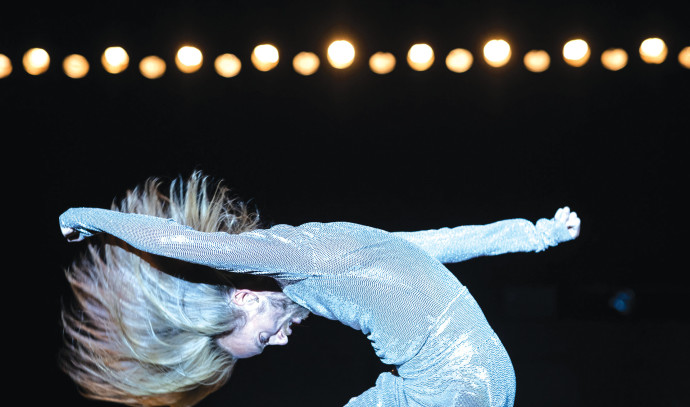|
Getting your Trinity Audio player ready...
|
Over the past two weeks, thousands have crowded into the huge warehouse-turned-performance space, Hangar 11, to partake of Batsheva Dance Company’s 2023 revival of Ohad Naharin’s expansive playground, Anafaza. The artistic director of Batsheva until 2018, when he became house choreographer, Naharin is, by far, the most celebrated of Israeli choreographers and needs no introduction in international arenas.
Anafaza, Naharin’s shameless dance extravaganza made its debut in December 1993, on the 30th anniversary of Batsheva’s foundation. It has been re-staged several times and over the years and exposure has reached some 300,000 audience members at home and abroad.
Naharin has never tiptoed quietly when executing his artistic vision. Soon after he accepted the position as artistic director in the early 1990s, he broke local dance conventions and redefined the Israeli dance scene, beginning with Kyr, a rock dance energy bomb.
Anafaza came later, ripe for the largest stages, rich in images and featuring a more contemporary perception of body movements. The Batsheva it showcased had come a long way from its original Martha-Graham-based incarnation.
Since then, Anafaza’s sizzling ace in the show, “Ehad Mi Yodea,” with a score by Tractor’s Revenge, has made media headlines. Initially, it was a milder scene embedded in another work, but it gained momentum when it became a national scandal for colliding with the Orthodox community.
Naharin brought Anafaza back a number of times over the years, and in Anafaza 2023 he took a brave step by tripling the number of “Ehad Mi Yodea,” dancers on folding chairs set in a semi-circle. Dressed as yeshiva students they jumped and fell, ignited by persistence; eventually they rid themselves of their black Fedora hats, followed by their jackets, shoes, and pants, flinging them all center stage, creating the sense of a bonfire waiting to happen. This “Ehad Mi Yodea” was larger, longer, more energetic and more effective than anything Naharin has done.
The rest of the evening was composed of several reconstructed scenes and a number of new ones, many of which were based on strong united fronts that became progressively more impressive as they grew in size. It was a wonderful opportunity to witness a powerful cadre of totally committed dancers.
Naharin managed to evade the lurking danger in large unison scenes and with his acute sense of timing and ability to shift focus, direction, and energy while innovating with a series of solos confronting a tight, massive wall of dancers.
Anafaza 2023 follows Naharin’s artistic path over past three decades
The 2023 version of Anafaza follows Naharin’s artistic path over the last three decades. In many ways, the development is enormous. The first Anafaza, in December 1993, was glamorous, bursting with fashion and color; a big party on our dance stages filled with crazy and curiously surreal images. The creative costumes were jaw-dropping. It was then that Naharin re-defined dance in Israel for the future to come.
Naharin is a decisive artist. Over the years he has stripped down unjustified decorative material and frivolous movement in Anafaza and in his choreography in general and dug deeper in order to touch the hidden layers of the art of dancing. His dynamic research into movement led him to invent a system of dance training he finally named Gaga in 2003, a radical way to relate to contemporary body and performance. Today, it is a well-known practice that many international dance companies, individual dancers, and even lay people experiment with. Gaga classes are open to the public in two main tracks: Gaga/people and Gaga/dancers.
One cannot ignore the way in which social awareness and political issues have a way of sneaking into Batsheva’s repertoire – at times subtly, at others with a more obvious touch.
On Anafaza 2023’s soundtrack, we hear the recorded words of one of our leading authors, David Grossman, speaking about current tensions and unstable future. He shares his feelings of fear that he may lose his home, meaning his safety and his future, in a country whose horizons he had never doubted before.
This mixture of old and new, the need to conserve parts of the past, the sensitivity to weakness, and the mounds of flaming passions combined with a touch of cynicism and a hidden sense of humor – as well as endless curiosity – are some of the things that will define the talented Naharin and his “Ehad Mi Yodea” forever.
Upcoming performances of Anafaza take place on June 29, 9 p.m.; June 30, 2 p.m.; July 1 10 p.m., show lasts 90 min., (03) 517 1471, [email protected]



